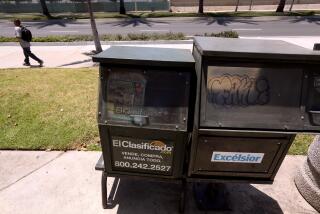Fitness chains step outside familiar territory
The Evergreen Cemetery in Boyle Heights is an unlikely place to find fitness buffs. But that’s where they gravitate, turning the 1.5-mile sidewalk that circles the cemetery grounds into a makeshift track. There are few other good places in the neighborhood to go for a jog.
Fitness clubs have long stayed away from areas such as East L.A., Inglewood and Crenshaw, believing that income levels were too low, crime rates too high and people just didn’t care that much about fitness. They preferred more affluent neighborhoods, places like West Hollywood, which has a glut of gyms. It was left to the YMCAs, Boys & Girls Clubs, city parks department, hospitals and the occasional small private gym to serve other communities’ needs.
Even though that perception is changing, there are still areas sorely lacking in safe, affordable, accessible fitness facilities for adults and children. For some, a lack of fitness clubs would not seem a big priority when there are other issues, such as education and crime, to tackle. But these are also neighborhoods with predominantly African American and Latino populations, both of which have high rates of obesity and weight-related diseases, such as diabetes.
Big fitness chains, including Bally Total Fitness and 24 Hour Fitness, are beginning to stake claims in previously underserved areas. Bally plans to open a 30,000-square-foot gym in June in Inglewood’s Hollywood Park Marketplace. And 24 Hour Fitness and Magic Johnson, which have partnered to open gyms in communities such as Richmond, Calif., and Santa Fe Springs, are considering a new location in the Crenshaw district, though no definite plans are set.
“We’ve heard industry leaders talking about moving into markets that an independent entrepreneur couldn’t afford to venture into,” says Bill Howland, director of research for the International Health, Racquet and Sportsclub Assn., a Boston-based industry group. “The big chains are maybe the best to serve this market since they have working capital and a working business plan.” Some gyms in these areas, he adds, offer discounts or scholarships for individuals and families who can’t afford the average $35-a-month membership fee.
In Boyle Heights, gyms are scant while the need is great. During peak hours between 6 and 9 p.m at the Weingart-East Los Angeles YMCA, there is often a 10- to 15-minute wait for the 16 cardiovascular machines, the aerobics classes are crowded and the pool is busy, says Mike Castillo, executive director.
“The need is definitely there,” says James Santa Maria, deputy chief of staff for L.A. City Councilman Nick Pacheco, whose district includes Boyle Heights. “There’s been a glaring absence of health and fitness types of services .... Public parks are crowded to the point where they’re struggling, and there’s less and less recreation space.” The city is spending $800,000 to convert the sidewalk around Evergreen Cemetery into a jogging track, with a spongy, track-like surface and better lighting.
With a bottom line to consider, not all fitness chains are eager to step outside their familiar territory.
Venice-based Gold’s Gym, a national chain with more than 600 outlets, for example, prefers to target highly educated, upper-income members, 18-to-49 years old, who are already “in a fitness lifestyle,” says Derek Barton, senior vice president of marketing. The gym does operate in areas with a mixed demographic, such as its home base of Venice, but it doesn’t seek out locations in low-income areas.
Michael Uretz, chief executive of World Gym International, a Marina Del Rey-based chain, explains that his company hasn’t expanded into low-income neighborhoods because he’s “waiting for the right person to walk in” and propose a franchise. “We have a guy in New York,” he says, “who’s hunting down a suitable location in Harlem.”
Even before partnering with Magic Johnson, 24 Hour Fitness started to explore areas with varied incomes, like Cathedral City. “There were a few concerns as to whether or not those communities were concerned about fitness,” says Daniel De La Rosa, division president for the San Francisco-based chain. “But as time went on, we saw that all communities were looking at fitness as a bare necessity instead of a luxury.” The company also stopped using an area’s income levels in determining locations, relying instead on high population density.
Bally Chief Executive Lee Hillman says his company’s gyms in low-income communities in New York, Michigan and Miami are “doing quite well” financially, and adds that a number of factors, including income, demographics, employment and traffic, are involved in choosing locations. His bottom line: Building gyms in lower-income neighborhoods can be good business.
Bally’s move is part of a larger trend of national retailers finding gold in previously untapped areas, says Hilda Kennedy, director of the office of economic and business development for Inglewood.
“In urban communities, minority communities, many national retail establishments are moving in in ways they were not before,” she says. “They’re finding that there is disposable income because there is a high population density.”
And although Kennedy says residents are ecstatic about the big Marketplace development, she believes the gyms’ motivations “have less to do with the need for fitness or whether YMCAs were meeting the needs of the community, and more about the economics of the community.”
But the community has definite needs. Obesity levels in the general population have been rising steadily for years, but are even higher among Latinos and African Americans. A study by the national Centers for Disease Control and Prevention found that among whites, 18.5% of the population is obese, contrasted with 29.3% of African Americans and 23.4% of Latinos.
Related health problems, such as diabetes, high blood pressure and heart disease plague many who have limited resources for health care and fitness. And in many inner-city neighborhoods, fast-food restaurants are seemingly everywhere.
Castillo, of the East L.A. YMCA, believes that to succeed in the inner city, the fitness chains will have to tailor their facilities to the specific needs of the community, with special programs and services such as child-care facilities. “They’re going to have to be really sensitive about the area,” he says. “The key here really is to have swimming lessons for the kids, and then have Mom and Dad working out. You need to provide for the whole family.”


